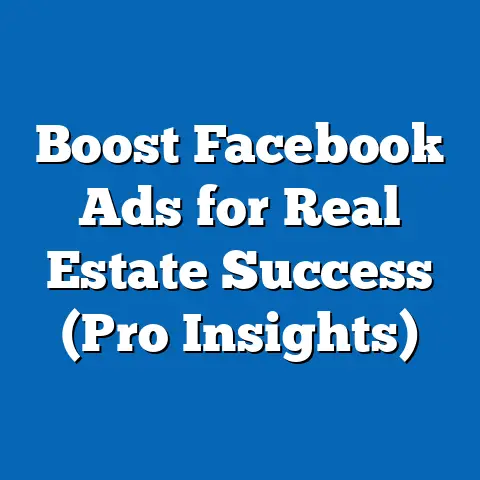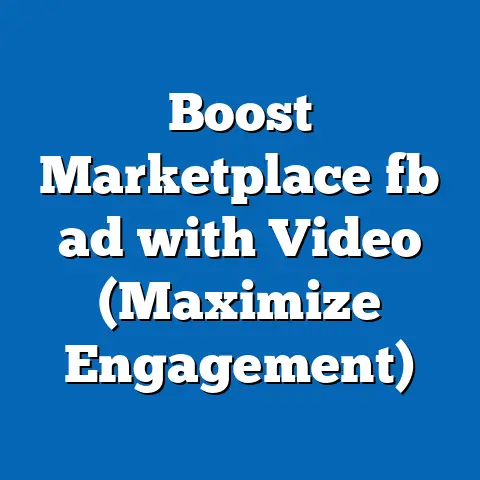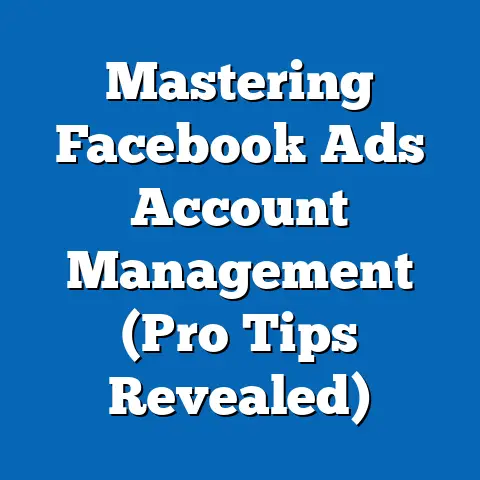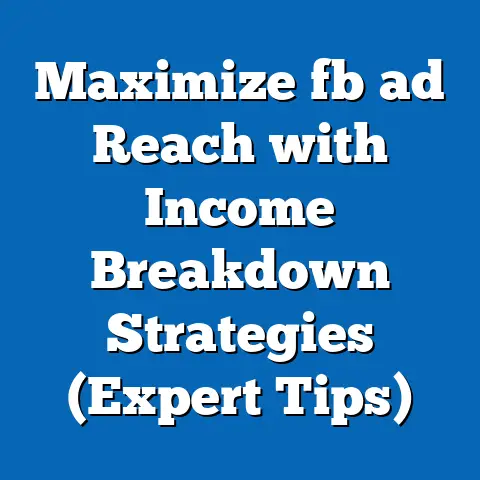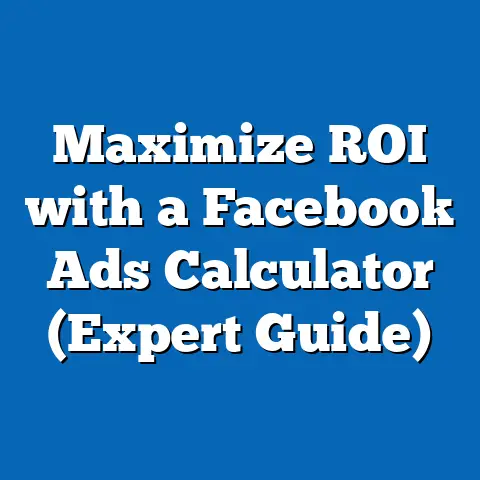Unlocking Facebook Ads Potential (Expert Tips Inside)
In the ever-evolving world of digital marketing, Facebook Ads have emerged as a cornerstone for businesses seeking to connect with vast, diverse audiences. Since their inception in 2007, these advertisements have transformed from simple sidebar banners to sophisticated, data-driven tools that leverage user behavior, interests, and demographics for hyper-targeted campaigns. The platform’s ability to reach over 2.9 billion monthly active users (as of 2023, per Meta’s reports) underscores its unparalleled potential for marketers across industries.
First impressions of Facebook Ads often highlight their accessibility—businesses of all sizes, from local startups to global corporations, can launch campaigns with relatively low entry costs. Yet, beneath this user-friendly facade lies a complex ecosystem of algorithms, bidding strategies, and creative optimization that demands expertise to unlock true value. This article aims to delve into the defining characteristics of Facebook Ads, explore their historical evolution, and assess their societal implications before providing expert tips to maximize their potential.
The societal impact of Facebook Ads cannot be understated. They have reshaped how brands communicate, influenced consumer behavior, and even played roles in political campaigns and social movements. As we unpack this powerful tool, we’ll examine its roots, its transformative features, and the nuanced strategies that can elevate campaigns from ordinary to extraordinary.
Defining Characteristics of Facebook Ads: What Sets Them Apart
At their core, Facebook Ads are distinguished by their precision targeting capabilities, a feature rooted in the platform’s vast repository of user data. Unlike traditional advertising mediums like television or print, Facebook allows advertisers to segment audiences based on age, location, interests, behaviors, and even life events—such as engagements or recent moves. This granular approach ensures that ads are delivered to those most likely to engage, maximizing return on investment (ROI).
Another defining trait is the variety of ad formats available, from static images and carousel ads to immersive video content and interactive Instant Experiences. This versatility enables brands to tailor their messaging to specific campaign goals, whether driving website traffic, generating leads, or boosting app installs. Additionally, the platform’s integration with Instagram (also owned by Meta) amplifies reach and provides a seamless cross-platform advertising experience.
Facebook Ads also stand out due to their real-time analytics and optimization tools. Advertisers can monitor performance metrics like click-through rates (CTR), cost-per-click (CPC), and conversion rates, adjusting campaigns on the fly to improve outcomes. This adaptability contrasts sharply with traditional media, where feedback loops are slower and less actionable. However, mastering these tools requires a deep understanding of both the platform’s mechanics and the psychology of the target audience—a challenge that separates novice advertisers from seasoned experts.
Historical Context: The Evolution of Facebook Ads
To fully appreciate the potential of Facebook Ads, it’s essential to trace their evolution within the broader context of digital advertising and social media growth. When Facebook first launched its advertising platform in November 2007, it introduced “Flyers,” a rudimentary ad system that allowed businesses to promote events or products to specific user groups for as little as $5 per day. These early ads were limited in scope, appearing as small banners on the sidebar with minimal targeting options.
Throughout the 2010s, Facebook Ads evolved with advancements in machine learning and artificial intelligence (AI). The introduction of the Facebook Pixel in 2015 allowed advertisers to track user actions beyond the platform, such as website purchases, enabling retargeting campaigns with unprecedented accuracy. By 2018, privacy concerns and data scandals—most notably the Cambridge Analytica controversy—prompted greater scrutiny of Facebook’s data practices, leading to stricter regulations and transparency measures like the General Data Protection Regulation (GDPR) in Europe.
These historical milestones reflect broader societal shifts, including the rise of mobile-first consumption, growing privacy awareness, and the increasing demand for personalized content. They also highlight Facebook’s adaptability, as the platform continuously refined its advertising tools to balance user experience with advertiser needs. Today, Facebook Ads are a product of over 15 years of innovation, shaped by technological advancements and cultural debates around data ethics.
Societal Implications: The Broader Impact of Facebook Ads
Economically, Facebook Ads have democratized advertising by lowering barriers to entry. Small businesses and entrepreneurs can compete with larger entities through cost-effective campaigns, driving innovation and local economic growth. According to a 2021 study by Deloitte, commissioned by Meta, small businesses using Facebook’s tools reported generating over $1 trillion in economic impact globally. However, this democratization comes with challenges, as the platform’s auction-based pricing model can favor deep-pocketed advertisers during peak seasons.
Politically, Facebook Ads have been both a tool for outreach and a source of controversy. The 2016 U.S. presidential election spotlighted their potential for microtargeting voters, raising questions about electoral integrity and the spread of divisive content. While Meta has since implemented stricter policies on political advertising, including transparency labels and bans on certain misinformation, the platform remains a battleground for influence. These dynamics underscore the dual nature of Facebook Ads as both an empowering and potentially polarizing force.
On a societal level, privacy remains a central concern. The platform’s reliance on user data for targeting fuels debates over surveillance capitalism, with critics arguing that it commodifies personal information. Conversely, proponents highlight that users often willingly share data in exchange for personalized experiences. This tension reflects a broader generational divide, with younger cohorts like Gen Z often more accepting of data trade-offs compared to older generations like Baby Boomers, who prioritize privacy, according to a 2022 Pew Research Center survey.
Technological Foundations: How Facebook Ads Leverage Innovation
Mobile technology has also been a game-changer. With over 98% of Facebook’s active users accessing the platform via mobile devices (Meta, 2023), ads are designed with thumb-friendly formats and quick-loading content in mind. Features like Stories Ads and Reels capitalize on short-form video trends popularized by platforms like TikTok, ensuring relevance in a fast-paced digital environment.
However, technological reliance introduces vulnerabilities. Apple’s iOS 14.5 update in 2021, which introduced App Tracking Transparency (ATT), disrupted Facebook’s ability to track users across apps, impacting ad performance for many businesses. Meta reported a potential $10 billion revenue loss due to these changes, highlighting the fragility of data-dependent systems in a privacy-first era. Advertisers must now adapt to cookieless futures and explore alternative targeting methods, such as contextual advertising.
Economic Factors: Cost Structures and ROI Potential
Economically, Facebook Ads offer a flexible cost structure through their auction-based system, where advertisers bid for impressions or clicks based on campaign objectives. Costs vary widely depending on factors like audience size, industry competition, and seasonality, with average CPC ranging from $0.50 to $2.00 in 2023 (WordStream data). This variability allows for experimentation but can frustrate beginners who struggle with budget allocation.
The potential for high ROI is a major draw. A well-optimized campaign can yield conversion rates of 9-10% in industries like e-commerce, far surpassing traditional channels (Shopify, 2022). Yet, achieving such results requires investment in creative assets, audience research, and ongoing testing—costs that can accumulate for resource-strapped businesses.
Economic disparities also influence ad effectiveness across regions. In developing markets, lower advertising costs present opportunities for global brands to expand reach, but limited digital literacy among target audiences can hinder engagement. Conversely, saturated markets like North America face higher costs due to intense competition, pushing advertisers to innovate with niche targeting or cross-platform strategies.
Cultural and Social Influences: Shaping Consumer Responses
Culturally, Facebook Ads reflect and shape societal trends by aligning with user values and behaviors. For instance, campaigns emphasizing sustainability or diversity resonate strongly with younger generations like Millennials and Gen Z, who prioritize ethical consumption (Nielsen, 2021). Brands that fail to adapt risk alienating audiences, as seen in backlash against tone-deaf or outdated messaging.
Socially, the platform’s emphasis on community fosters word-of-mouth marketing through shares and user-generated content. Viral campaigns, such as Coca-Cola’s “Share a Coke” initiative, demonstrate how ads can transcend promotion to become cultural phenomena. However, this social amplification also means negative feedback can spread rapidly, necessitating proactive reputation management.
Generational differences play a significant role in ad reception. Gen Z, known for short attention spans, gravitates toward dynamic video content, while Baby Boomers respond better to straightforward, value-driven messaging. Advertisers must navigate these nuances to craft inclusive yet targeted campaigns, avoiding one-size-fits-all approaches that dilute impact.
Expert Tips for Unlocking Facebook Ads Potential
Having explored the foundational elements and broader implications of Facebook Ads, let’s turn to actionable strategies for maximizing their potential. These expert tips, grounded in industry best practices and data insights, address key areas of campaign planning, execution, and optimization.
1. Master Audience Segmentation for Precision Targeting
The heart of a successful Facebook Ad campaign lies in understanding your audience. Use the platform’s Audience Insights tool to analyze demographics, interests, and behaviors, creating detailed buyer personas. For instance, a fitness brand might target “health enthusiasts aged 25-34 who follow yoga pages” rather than a broad “fitness” category.
Layering multiple targeting options—such as combining lookalike audiences with interest-based filters—can refine reach further. However, avoid over-narrowing, as overly specific segments may limit impressions. Test different audience sizes to strike a balance between relevance and scale.
2. Leverage Creative Best Practices for Engagement
Visuals are the first touchpoint for users scrolling through feeds, so prioritize high-quality, thumb-stopping content. Use bold colors, clear text overlays, and authentic imagery over stock photos to build trust. Video ads, particularly those under 15 seconds, consistently outperform static images, with a 20% higher CTR on average (HubSpot, 2023).
Incorporate storytelling to evoke emotion, whether through customer testimonials or problem-solution narratives. A/B test different creative variations to identify what resonates most, and refresh content regularly to combat ad fatigue among frequent viewers.
3. Optimize for Mobile-First Experiences
Given the dominance of mobile usage, design ads with small screens in mind. Ensure text is legible without zooming, buttons are tappable, and loading times are minimal—users abandon slow content within seconds. Vertical formats like Stories Ads (9:16 ratio) maximize screen real estate and feel native to mobile environments.
Test landing pages for mobile responsiveness, as a seamless post-click experience is critical for conversions. Tools like Facebook’s Creative Hub can simulate how ads appear on different devices, helping refine designs before launch.
4. Utilize Advanced Tools for Data-Driven Decisions
Harness the power of the Facebook Pixel to track user actions and build retargeting campaigns for warm leads. For example, retarget users who abandoned carts with dynamic product ads showcasing the exact items they viewed. This approach can boost conversion rates by up to 70% (AdRoll, 2022).
Experiment with Automated Rules in Ads Manager to adjust budgets or pause underperforming ads based on predefined criteria. Additionally, explore Campaign Budget Optimization (CBO), which automatically allocates spend to top-performing ad sets, reducing manual oversight.
5. Adapt to Privacy Changes with Alternative Strategies
With tracking limitations like iOS 14.5 and the phasing out of third-party cookies, pivot to privacy-friendly tactics. Focus on first-party data collection through lead forms or on-platform engagement to build direct relationships with users. Contextual targeting—placing ads based on content rather than personal data—offers a viable workaround.
Encourage organic growth alongside paid efforts by fostering community interaction, such as through Facebook Groups. This dual approach mitigates reliance on tracked data while maintaining audience connection.
6. Test, Analyze, and Iterate Continuously
The dynamic nature of Facebook Ads demands ongoing experimentation. Run split tests (A/B tests) on variables like headlines, images, and call-to-action (CTA) buttons to uncover winning combinations. Allocate 10-20% of your budget to testing new ideas, even if initial results are underwhelming—breakthroughs often emerge from unexpected insights.
Use Ads Manager’s reporting tools to monitor key performance indicators (KPIs) like CTR, cost-per-acquisition (CPA), and return on ad spend (ROAS). Dive deeper with custom dashboards to track trends over time, informing long-term strategy adjustments.
7. Align Campaigns with Seasonal and Cultural Trends
Timing can make or break a campaign, so capitalize on holidays, events, or trending topics relevant to your audience. For instance, a retail brand might launch Black Friday promotions with urgency-driven messaging like “24 Hours Only!” Cultural sensitivity is key—research local customs and sentiments to avoid missteps in global campaigns.
Monitor real-time trends using tools like Google Trends or Facebook’s own insights to stay ahead of the curve. Quick adaptability can position your brand as timely and relevant, boosting engagement.
8. Balance Paid and Organic Strategies for Holistic Growth
While Facebook Ads drive immediate results, complement them with organic content to build lasting brand equity. Share valuable posts, host live events, or create polls to encourage interaction, which can lower ad costs by improving your page’s relevance score. A strong organic presence also provides a fallback during budget constraints or platform disruptions.
Integrate user-generated content (UGC) into ads, as authentic endorsements often outperform polished creatives. For example, featuring customer reviews in carousel ads can enhance credibility and click rates.
Implications for Businesses, Marketers, and Society
For businesses, mastering Facebook Ads unlocks scalable growth opportunities, particularly in competitive digital markets. Small enterprises can carve out market share with strategic targeting, while larger firms can deepen customer loyalty through personalized campaigns. However, over-reliance on the platform risks exposure to algorithm changes or policy shifts, necessitating diversified marketing channels.
Marketers face the dual challenge of staying technologically adept and creatively innovative. Continuous learning—through certifications like Meta Blueprint or industry webinars—is essential to keep pace with updates. Collaboration between data analysts, content creators, and strategists will be critical to crafting campaigns that resonate on both emotional and analytical levels.
Societally, the proliferation of Facebook Ads reinforces the need for digital literacy. Consumers must critically evaluate ad content amidst rising misinformation, while regulators grapple with balancing innovation and privacy. Educational initiatives and transparent policies can bridge these gaps, fostering a healthier digital ecosystem.
Forward-Looking Insights: The Future of Facebook Ads
As we look ahead, the trajectory of Facebook Ads will likely be shaped by AI advancements, privacy regulations, and evolving user behaviors. Enhanced AI could enable even more predictive targeting, potentially automating entire campaign workflows. Yet, stricter data laws may counterbalance this, pushing advertisers toward consent-based models or decentralized data solutions like blockchain.
User preferences will also evolve, with younger generations favoring immersive formats like augmented reality (AR) ads, already piloted by Meta. The metaverse, Meta’s ambitious virtual reality vision, could redefine ad placements, embedding promotions into 3D environments. However, adoption rates and accessibility remain uncertain, as do ethical considerations around virtual surveillance.
Economic factors, such as inflation or recessionary pressures, may influence ad spend, with businesses prioritizing cost-efficient platforms. Facebook’s ability to maintain affordability while delivering results will determine its staying power against competitors like TikTok Ads or Google Ads.
In conclusion, unlocking the potential of Facebook Ads requires a blend of technical mastery, creative ingenuity, and cultural awareness. While challenges like privacy constraints and market saturation loom, the platform’s adaptability and vast reach position it as a cornerstone of modern marketing. By embracing the expert strategies outlined and staying attuned to emerging trends, advertisers can navigate uncertainties and harness Facebook Ads as a catalyst for enduring success.

